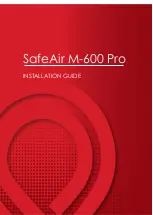
13
To position the pointer correctly, the switch endpoints need to be adjusted in the transmitter. On most
radios this can be done in real time whilst transmitting, so it is easy enough to move the pointer around
until it hits each mark. Try to position it in the centre of the small workable range so that minor shifts
won't cause failure. The transmitter should have a separate setting for each end, plus it may have a
centre adjustment for a 3-position switch.
Finding the right settings within the transmitter may take some time, calling for diligent study of the
instruction manual! They are often buried in sub-menus, and require a particular sequence of button
entries to select the required function and then to change it.
When all settings are complete, disconnect the USB cable, unplug the QuadPod's battery and
turn off the transmitter.
Please note: If it is necessary to re-bind the RC system in the future, then it is important to set
the
receiver's
failsafe for Channel 5 to a position where it will trigger the Naza Lite's failsafe, in
other words, to an
in
correct position for selecting one of the Naza's flight modes. This is to make
sure that the Naza will enter failsafe if the transmitter signal is lost. It is easiest to set one
Channel 5 endpoint to 100% temporarily, whilst the RC system is bound. This will then be set as
the receiver's Channel 5 failsafe position. Make sure it works correctly!
Preliminary Testing
20)
It is a good idea to test the QuadPod at this stage,
before
the propellers are fitted. This will prevent
possible accidents if something goes wrong.
Begin by switching on the transmitter and then powering up the QuadPod – note that it's
important to do it in that order, so that the Naza Lite can acquire the joystick centres correctly.
After its initial multi-coloured light display during which
the joysticks should not be moved
,
the Naza's status LED should settle down into regular yellow blinks spaced about two seconds
apart, like this:
If any of the joysticks is moved off-centre (except the throttle), then each yellow blink will
become a double one, like this:
When the motors are running, the double blinks will also appear if the throttle is off-centre. To
get the single blinks the throttle stick must be centred, whereupon the barometric control will try
to maintain constant height. Stick positions above or below centre will cause the aircraft to
climb or descend.
Prior to starting the motors, the single yellow blinks indicate that the QuadPod is ready to fly.
If the yellow blinks do not appear at all then it means that the QuadPod is set to Manual flight
mode. In this mode it is not self-levelling and barometric height control is inoperative. We
recommend switching to self levelling (called "Atti" mode), using the Channel 5 switch on the
transmitter.
If the LED gives continuous rapid yellow blinks, then it means that the transmitter signal is not
correct, and the Naza Lite has entered failsafe mode:
Check that the receiver has linked to the transmitter - most have an indicator light to confirm
this. Otherwise, the problem is most likely caused by incorrect setting of the Channel 5
endpoints in the transmitter. Please refer to Step 19 above.
Please see Page 19 for a summary of the various status LED indications and their meanings.
. . .
etc
. . .
etc
. . .
etc




























